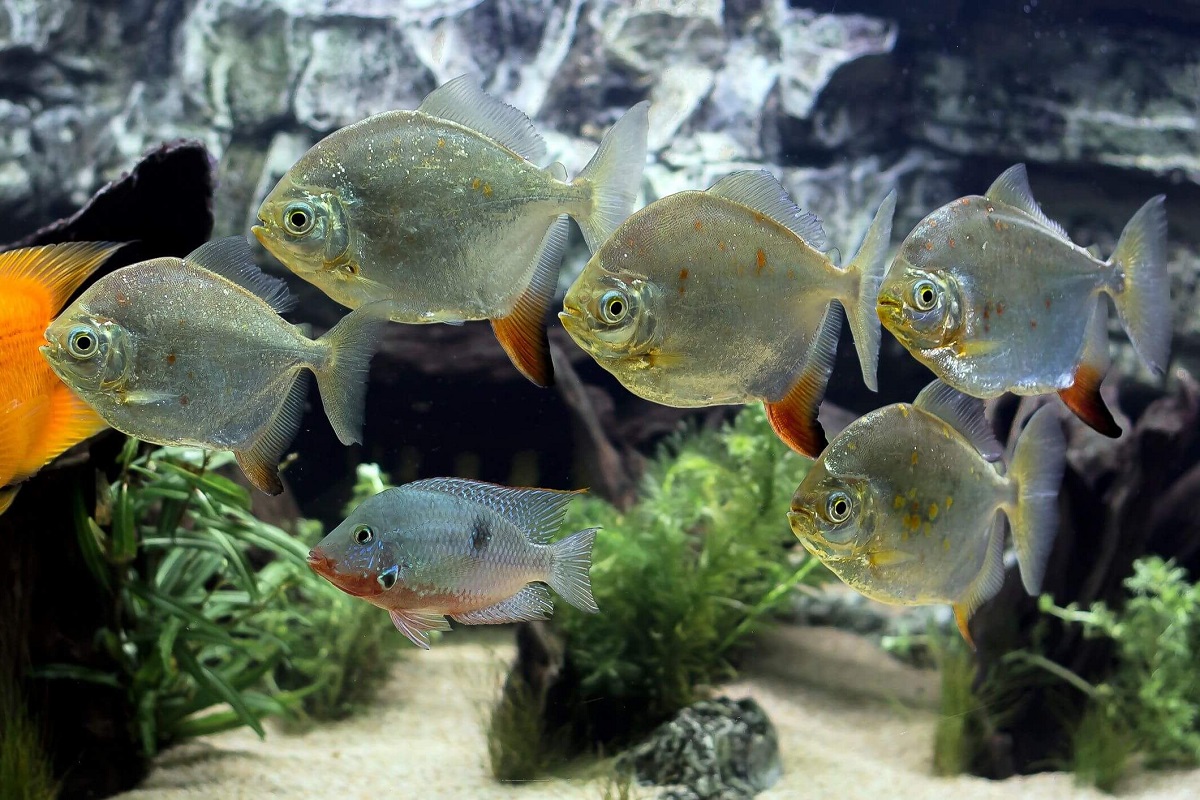Silver dollar fish live naturally in South America. They are also a popular option for freshwater tanks. They are active yet friendly fish and make a great addition to community tanks.
They come in a variety of colors that will brighten up your tank. If you’re looking for a lively and beautiful fish, these are a great pick.
Caring for silver dollar fish is easy and it’s easy to breed them as well. If you’ve been looking for a new fish to add to your home aquarium, you should check out these amazing fish.
Want to learn more about silver dollar fish? We have you covered. Below is a comprehensive guide to silver dollar fish care.
Contents
What Is a Silver Dollar Fish?
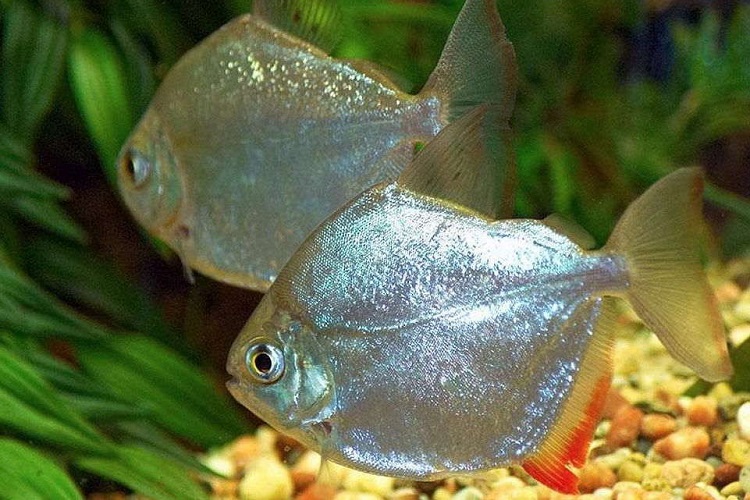
The silver dollar fish is native to South American rivers like the Amazon in Brazil. They live in heavy and long vegetation and have a body built to successfully navigate this environment.
Commonly called silver dollar fish or plant piranhas, the scientific name of these fish is metynnis argenteus. They come from the Characidae family.
While from the same family as piranha (Characidae), the silver dollar fish eats mostly plants. They are natural herbivores yet do sometimes eat meat. These freshwater fish have a long lifespan and are hardy.
They are a naturally communal fish that is easy to breed, eats a variety of foods, and works great with bottom-feeding fish.
Silver Dollar Fish Appearance
Named after their flat, circular, and tall bodies, the silver dollar fish looks like a silver dollar. This tropical fish has a shiny silver body that is more translucent near its fins. This adds to their circular silver dollar appearance.
They have a dorsal fin that starts near the top of their body. This fin is normally more opaque than the rest of the body. They also have symmetrical caudal fins.
Most silver dollar fish grow to be 6 inches in length. While uncommon, some grow up to 8 inches in length. This means you’ll need a large tank if you plan to have a small school of silver dollar fish in your home aquarium.
Types of Silver Dollar Fish
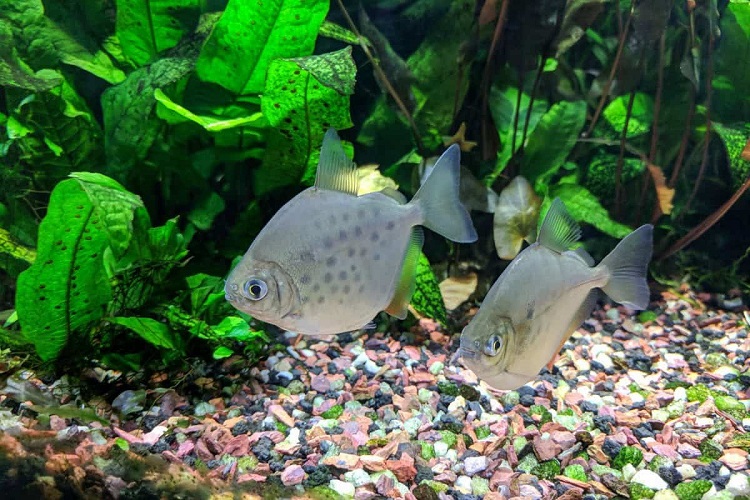
You’ll find a few different varieties of silver dollar fish for your aquarium.
Common silver dollar fish have a kite-shaped body and are silver. The average adult size is 6 inches but they can grow up to 8 inches. They need space to swim freely and can jump from the tank.
Black bar silver dollar fish are rare. They grow up to 4 inches and feature a black-colored fin at their base. They have the same kite-shaped body as other silver dollar fish.
Red hook silver dollar fish has a red anal fin. The rest of the fish has the common silver color of the species. Some red hook fish may have some patchy coloration to their bodies as well.
If you want a fish with more color, the spotted silver dollar fish is an option. This variation features a darker body and is covered in dark brown spots.
The spotted silver dollar fish has the same size and shape as most other silver dollar fish. The body of these fish is covered in black spots.
Finally, the tiger silver dollar fish features a blue-silver body with dark vertical stripes.
Silver Dollar Fish Behavior
The silver dollar fish is a calm, non-aggressive fish. They are active and are schooling fish. This makes them a great addition to a communal tank. They spend most of their time at the top of the tank making them a good addition to tanks that already have bottom-feeding fish.
Tank Size for Silver Dollar Fish
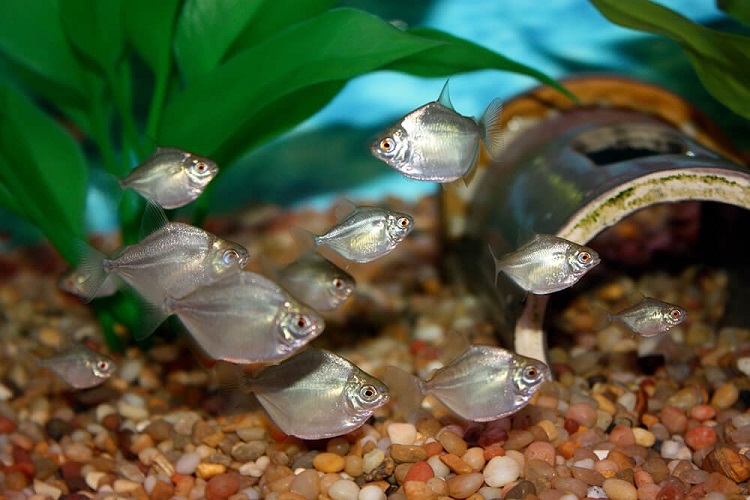
The silver dollar fish is a community fish that enjoys swimming in schools. It’s also quite large. This means you should aim for a 75-gallon or larger tank for 5 fish.
This tank allows the fish to swim in schools and they’ll have plenty of room to roam. Longer tanks are ideal since these fish enjoy swimming.
If you plan on adding additional fish you should add 15 gallons per extra fish.
Water Parameters for a Silver Dollar Fish Tank
You’ll want to ensure your tank is well-maintained and clean so you provide the best environment for your fish. Below are water parameters and water quality specifications for a silver dollar fish aquarium.
- Water Temperature between 75 F to 82 F is ideal.
- Aim for a soft water with a pH level of 5-7.
- Water hardness should be between 4 and 8 dGH (degrees of water hardness).
- You should have a minimum of 75 gallons for 5 fish.
- Water changes should occur at normal intervals to keep the water fresh and clean.
Since they spend most of their time at the top of the tank, you’ll want to reduce the light in the room. These fish prefer dim lighting and shadowy areas that will reduce their stress.
You’ll want to measure the pH of your tank every time you change the water. Alkaline buffers are used to raise pH while acid buffers will lower the pH of your water. You should shoot for a pH between 5 and 7. Many breeders recommend a stricter guideline between 6.0 and 7.5 pH.
Hardness measures calcium carbonate content in your water. Silver dollar fish like living in soft water between 4 and 8 dH. If your water is too hard, you can use reverse osmosis to reduce the hardness. You can also use aquarium peat to lower the hardness. If you need to harden the water you should add calcium-based rocks to your aquarium.
Most professionals recommend partially changing the water of your tank. Every two weeks you should replace 25% of the water in the tank. If you are using tap water, please test the water’s pH and hardness before adding it to the tank. You should match the above requirements before adding the new water to the tank.
What Else Does Your Silver Dollar Fish Tank Need?
You’ll want to add plenty of plants to your tank that simulates their natural habitat. Silver dollar fish are used to swim through plants in the Amazon and other South American rivers.
Using plastic plants is a good idea since the fish may eat live plants. If you do want to add live plants, java moss and hornwort are good options that silver dollar fish won’t eat.
Floating plants should also be part of the environment in your aquarium.
Don’t forget rocks and driftwood at the bottom of the tank. You can also feel free to add plastic toys and accessories to the tank. This gives your fish somewhere to hide and relax when needed.
Is Sand Substrate Needed for Silver Dollar Fish?
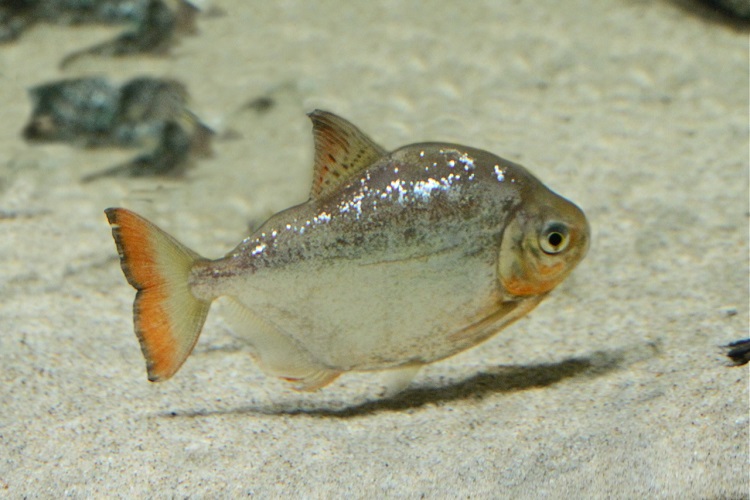
For best results, you’ll want to use a dark substrate for your silver dollar fish. You can use either sand or gravel substrate for a silver dollar fish tank. Since silver dollar fish are freshwater fish, you don’t need sand.
Silver dollar fish spend most of their time at the top of the tank and don’t burrow into the sand. Gravel substrate also mimics the riverbeds these fish are used to in the wild.
They also prefer darker substrate, letting you choose gravel that matches your aesthetic for the tank.
Best Food for Silver Dollar Fish
Silver dollar fish enjoy a mostly vegetarian diet. The best diet options include vegetable flake food, algae wafers, fresh leafy greens, or cooked spinach. Since they’re not picky, silver dollar fish also enjoy a variety of cooked vegetables including peas and squash.
If you plan on serving fresh food to your fish make sure to remove the uneaten portions once they finish eating. The Uneaten food decays in your tank and can ruin the water and cause diseases.
Silver dollar fish also enjoy meats and insects. You can serve them larvae, bloodworms, and brine shrimp as treats to provide supplemental nutrition.
You should plan for a two-times-a-day feeding schedule for silver-dollar fish.
Silver Dollar Fish Diseases
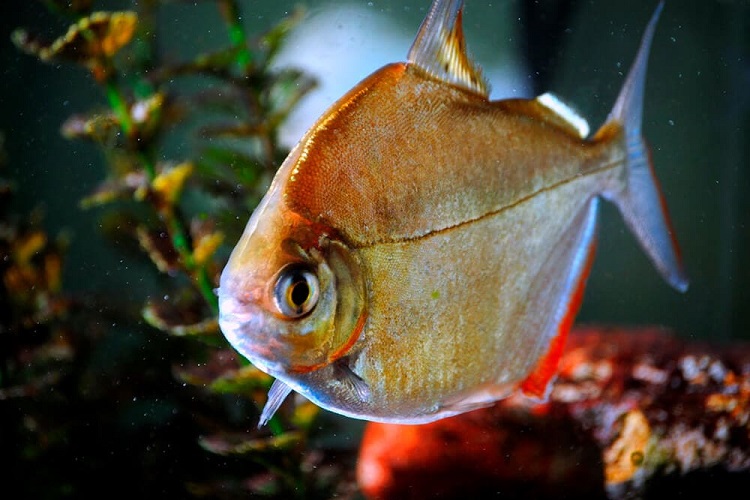
Luckily, you won’t have to worry about any species-specific diseases with silver dollar fish. These fish make maintaining a tank easy.
Of course, you do have to prepare for common fish and freshwater aquarium problems like ich, parasites, bacteria, and fungal diseases. These are common with all freshwater tanks.
Silver dollar fish are prone to blackspot and black ick. This is caused by a parasite. Black spots form from flatworms embedded in the skin of the fish. Luckily the disease is easy to treat and is rarely life-threatening.
Some silver dollar fish develop constipation due to their flat bodies. Adding fiber to their diets is the best way to treat this issue.
Fungal infections are also common in many freshwater fish tanks. These infections are treated with products you can get at your local pet store.
The best way to avoid disease is to maintain and clean your tank regularly. SIlver dollar fish prefer clean and clear water that is well-aerated and well filtered. Maintaining these water conditions and providing a healthy diet is the best way to avoid any diseases in your silver dollar fish tank.
Good and Bad Tank Mates for Silver Dollar Fish
Silver dollar fish are calm and gentle. This makes them a great option for multi-fish tanks. Since they spend most of their time at the top of the tank, bottom-feeder fish make ideal tank mates for silver dollar fish.
As long as the other fish match the same water requirements of your silver dollar fish, they should be fine as companions in your freshwater aquarium.
Due to their size and durability, silver dollar fish may mistake smaller fish for food. You should avoid breeds like betta and neon tetras to avoid this issue.
Some of the most common tank mates are below.
- Bristlenose
- Clown Plecos
- Kuhli Loaches
- Cory Catfish
- Doradids
- Cichlids
- Plecos
- Other South American freshwater fish.
You’ll also find silver dollar fish with goldfish, danios, pacu, and Bala fish.
Can You Breed Silver Dollar Fish in Aquariums?

Breeding your silver dollar fish is straightforward. As long as you have a healthy and large aquarium, you can breed your silver dollar fish.
Before breeding, you should start with 6 or more juvenile fish and raise them together. About one year into their life, they will reach maturity. You’ll also want to separate the males and females for seven to ten days before breeding begins. During this time their diet should consist of high-quality food to improve breeding success.
Breeding pairs should be removed from the school and added to their tank. This reduces the risk of other fish-eating the eggs. The breeding tank needs to be between 40 and 50 gallons in size.
Warm and soft water between 80F and 82F is optimal breeding water conditions for silver dollar fish. You should also keep the tank lighting dim and provide plastic leaf plants for the tank.
When the fish pair, the female will lay up to 2,000 eggs. The eggs fall to the bottom and hatch in three days. After seven days, the guppies will spawn and be ready to eat commercial fry food or brine shrimp.
FAQs on Silver Dollar Fish Care, Diet, and Tank Mates

What are the best tank mates for Silver Dollar fish?
For Silver Dollar fish, ideal tank mates include other peaceful, similarly sized species. Good choices are large tetras, barbs, and gouramis. It’s best to avoid very small fish, as Silver Dollars may inadvertently harm them.
Can you provide some tips on Silver Dollar fish care?
Effective Silver Dollar fish care involves maintaining a spacious tank (around 75 gallons for a group), regular water changes, and consistent monitoring of water parameters. They appreciate a mix of vegetation and open swimming spaces.
What is an appropriate Silver Dollar fish diet?
Silver Dollar fish thrive on a diet that includes high-quality plant-based foods like algae wafers, supplemented with occasional protein sources such as brine shrimp or bloodworms.
What do Silver Dollar fish eat in their natural habitat?
In their natural environment, Silver Dollar fish predominantly consume plant material, along with insects and small aquatic creatures.
What is the best food for Silver Dollar fish in captivity?
The best food for Silver Dollar fish includes a variety of herbivore-specific flakes or pellets, along with fresh vegetables like lettuce or zucchini, ensuring a well-rounded diet.
How often should Silver Dollar fish be fed?
Silver Dollar fish should be fed two to three times a day. Offer them enough food that they can consume within a few minutes to avoid overfeeding and maintain water quality.
Are there specific health concerns to be aware of for Silver Dollar fish?
While Silver Dollar fish are not prone to unique health issues, maintaining good water quality is essential to prevent common fish diseases.
Is it safe for Silver Dollar fish to be with smaller fish?
While Silver Dollar fish are generally peaceful, their size can pose a risk to much smaller fish. It’s advisable to keep them with medium to large-sized tank mates.
Do Silver Dollar fish need a planted aquarium?
Silver Dollar fish enjoy a planted environment, but they are known to nibble on plants. Choose hardy plant species that can withstand their grazing habits.
By understanding the needs and behaviors of Silver Dollar fish, including their tank mates, care requirements, diet, and feeding habits, you can create a thriving environment for these captivating aquarium inhabitants.
Final Thoughts
The silver dollar fish is an ideal fish species to add to your home aquarium. They are fun and friendly and live long lives. They’re also easy to care for.
This makes them an ideal addition to a communal tank. Even if you’re not an expert at fish keeping, silver dollar fish are a good option for newcomers to fish care.
Don’t forget that they are larger fish and enjoy swimming so make sure you have a big enough tank for a school of silver dollar fish.
Adding a school of silver dollar fish to your tank is a fun experience and you’ll get to enjoy them for years due to their long lifespan. We hope this guide helps you take excellent care of your new fish.
Did we miss anything or do you have any other questions concerning silver dollar fish and their care? We’d love to hear from you.

Ian Sterling, founder of Fishlab.com, began his aquarium journey over 30 years ago, driven by a deep fascination for fish and their diverse personalities. His website, Fishlab.com, is dedicated to making fishkeeping accessible and enjoyable, offering beginner-friendly guidance, expert insights, and a community for aquarists to connect and share experiences.


